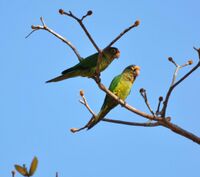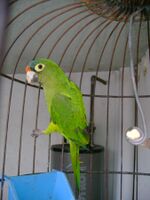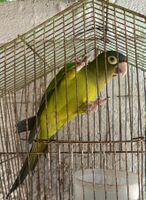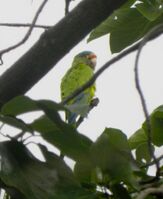Biology:Orange-fronted parakeet
| Orange-fronted parakeet | |
|---|---|
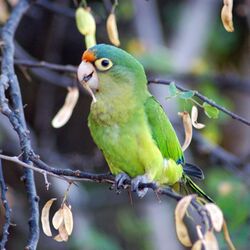
| |
| In a tree feeding on seeds, Gulf of Papagayo, Costa Rica | |
| Scientific classification | |
| Domain: | Eukaryota |
| Kingdom: | Animalia |
| Phylum: | Chordata |
| Class: | Aves |
| Order: | Psittaciformes |
| Family: | Psittacidae |
| Genus: | Eupsittula |
| Species: | E. canicularis
|
| Binomial name | |
| Eupsittula canicularis | |
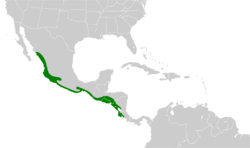
| |
| Synonyms | |
| |
The orange-fronted parakeet or orange-fronted conure (Eupsittula canicularis), also known as the half-moon conure, is a medium-sized parrot that is resident from western Mexico to Costa Rica.
Taxonomy
The orange-fronted parakeet was formally described in 1758 by the Swedish naturalist Carl Linnaeus in the tenth edition of his Systema Naturae. He placed it with all the other parrots in the genus Psittacus and coined the binomial name Psittacus canicularis.[2] The type locality is northwestern Costa Rica.[3] Linnaeus based his description on the "red and blue-headed parakeet" that had been described and illustrated in 1751 by the English naturalist George Edwards in the fourth part of his A Natural History of Common Birds.[4] The orange-fronted parakeet is now one of five species placed in the genus Eupsittula that was introduced in 1853 by the French naturalist Charles Lucien Bonaparte.[5][6] The genus name combines the Ancient Greek eu meaning "good" with the Modern Latin psittula meaning "little parrot". The specific epithet canicularis is Latin meaning "of the bright star Sirius".[7]
Three subspecies are recognised:[6]
- E. c. clarae (Moore, RT, 1937) – west-central Mexico
- E. c. eburnirostrum (Lesson, R, 1842) – southwest Mexico
- E. c. canicularis (Linnaeus, 1758) – south Mexico to west Costa Rica
Description
The orange-fronted parakeet is 23–25 cm (9.1–9.8 in) long and weighs 68–80 grams (2.4–2.8 oz). The adult is mainly green, paler and yellower below and with an olive tone to the breast. The wings have blue outer primaries and yellow linings, and the pointed tail is tipped with blue. The head is distinctive, with a blue crown, orange forehead, bare yellow eye-ring, yellow iris and white bill. Young birds are similar to the adults, but with much less orange on the forehead.[8]
Habitat and range
It is found in lowlands and foothills on the Pacific side of the central mountain ranges in forest canopy and edges, and more open woodland, including savanna and second growth.
Behaviour
The orange-fronted parakeet feeds in flocks which can reach 100 birds outside the breeding season, taking various seeds, flowers and fruits including figs. Its flight call is a raucous can-can-can, and when perched it has a reedy zeeweet.
Breeding
The 3–5 white eggs are laid in an unlined nest cavity, usually self-excavated in an arboreal termite nest of the termite species Nasutitermes nigriceps,[9] but sometimes in an old woodpecker hole or natural cavity.
Both the male and female half-moon conures excavate a cavity in the termite mound using their beaks (the male doing the majority of the digging) over the course of about a week. Following this, the birds leave the new cavity alone for 7-10 days, to allow time for the termites to seal off and abandon the damaged area. They then return and proceed to nest inside. Conure activity often causes the eventual disintegration of the termite nest due to irreparable structural damage, which provides an opportunity to predatory ants to enter the colony.[10]
Aviculture
The orange-fronted parakeet (more commonly known as the half-moon conure in aviculture) is sometimes kept as a companion parrot. An excitable, energetic bird that enjoys climbing and playing, it tends to be quieter than some other conure species and is good-natured when properly socialized. It is not noted as a talking bird, but may mimic a few words or sounds. In order to remain healthy, it requires regular mental stimulation and time outside of its cage in which to fly.[11]
The population has decreased in many areas due to persecution for the pet trade.
Gallery
See also
References
- ↑ BirdLife International (2020). "Eupsittula canicularis". IUCN Red List of Threatened Species 2020: e.T22685739A182075618. doi:10.2305/IUCN.UK.2020-3.RLTS.T22685739A182075618.en. https://www.iucnredlist.org/species/22685739/182075618. Retrieved 19 November 2021.
- ↑ Linnaeus, Carl (1758) (in Latin). Systema Naturae per regna tria naturae, secundum classes, ordines, genera, species, cum characteribus, differentiis, synonymis, locis. 1 (10th ed.). Holmiae (Stockholm): Laurentii Salvii. p. 98. https://www.biodiversitylibrary.org/page/727005.
- ↑ Peters, James Lee, ed (1937). Check-List of Birds of the World. 3. Cambridge, Massachusetts: Harvard University Press. p. 189. https://www.biodiversitylibrary.org/page/14477904.
- ↑ Edwards, George (1751). A Natural History of Uncommon Birds. 4. London: Printed for the author at the College of Physicians. p. 176. https://www.biodiversitylibrary.org/page/50196422.
- ↑ Bonaparte, Charles Lucien (1853). "Notes sur les collections rapportées en 1853, par M. A. Delattre" (in French). Comptes Rendus Hebdomadaires des Séances de l'Académie des Sciences 37: 806–810 [807]. https://www.biodiversitylibrary.org/page/1216907.
- ↑ 6.0 6.1 Gill, Frank; Donsker, David; Rasmussen, Pamela, eds (January 2022). "Parrots, cockatoos". IOC World Bird List Version 12.1. International Ornithologists' Union. https://www.worldbirdnames.org/bow/parrots/. Retrieved 17 March 2022.
- ↑ Jobling, James A. (2010). The Helm Dictionary of Scientific Bird Names. London: Christopher Helm. pp. 153, 88. ISBN 978-1-4081-2501-4.
- ↑ Collar, N.J. (1997). "Orange-fronted Parakeet". in del Hoyo, J.; Elliott, A.; Sargatal, J.. Handbook of the Birds of the World. 4: Sandgrouse to Cuckoos. Barcelona, Spain: Lynx Edicions. p. 435. ISBN 978-84-87334-22-1. https://archive.org/details/handbookofbirdso0004unse/page/435/mode/1up.
- ↑ Sanchez-Martinez, Tania; Renton, Katherine (2009). "Availability and selection of arboreal termitaria as nest-sites by Orange-fronted Parakeets Aratinga canicularis in conserved and modified landscapes in Mexico". Ibis 151 (2): 311–320. doi:10.1111/j.1474-919X.2009.00911.x.
- ↑ "The Half Moon, Orange-Fronted or Petz's Conure (Aratinga canicularis) and its Relationship with the Arboreal Black-Headed Termite (Nasutitermes nigriceps): The Uncommon Nesting Habits of a Common Pet". 9 March 2009. http://blogs.thatpetplace.com/thatbirdblog/2009/03/09/the-half-moon-orange-fronted-or-petzs-conure-aratinga-canicularis-and-its-relationship-with-the-arboreal-black-headed-termite-nasutitermes-nigriceps-the-uncommon-nesting-habits-of-a-com/#.Yn_uPR7TU0M.
- ↑ Kruzer, RVT, LVT, Adrienne. "Half-Moon Conure Species Profile". https://www.thesprucepets.com/half-moon-conure-species-profile-5077095.
- Stiles, F. Gary; Skutch, Alexander F. (1989). A Guide to the Birds of Costa Rica. Comstock Publishing Associates. ISBN 0-8014-9600-4.
External links
- BirdLife species factsheet for Eupsittula canicularis
- "Orange-fronted parakeet media". Internet Bird Collection. http://www.hbw.com/ibc/species/orange-fronted-parakeet-aratinga-canicularis.
- Orange-fronted parakeet photo gallery at VIREO (Drexel University)
Wikidata ☰ Q27074957 entry

